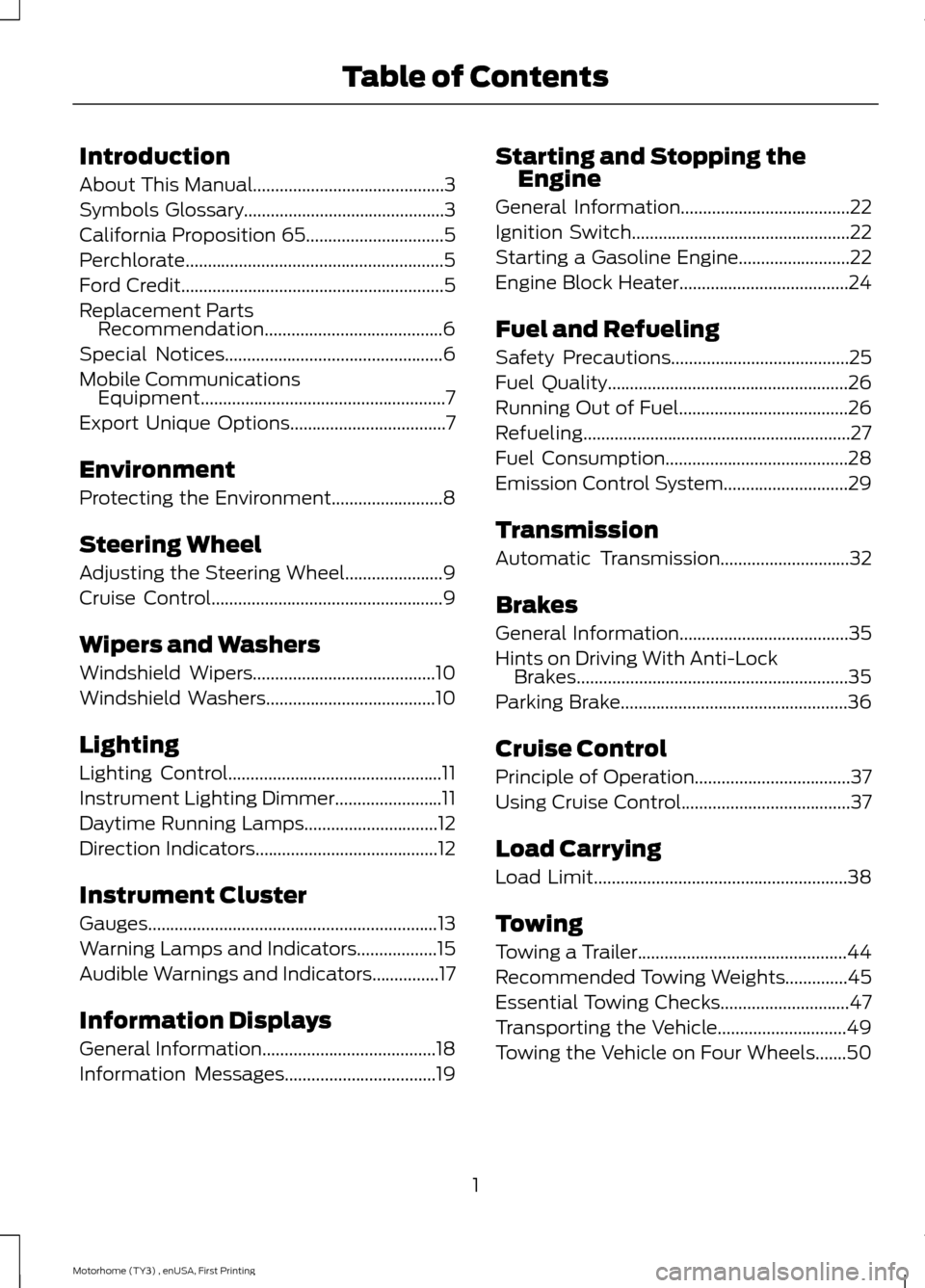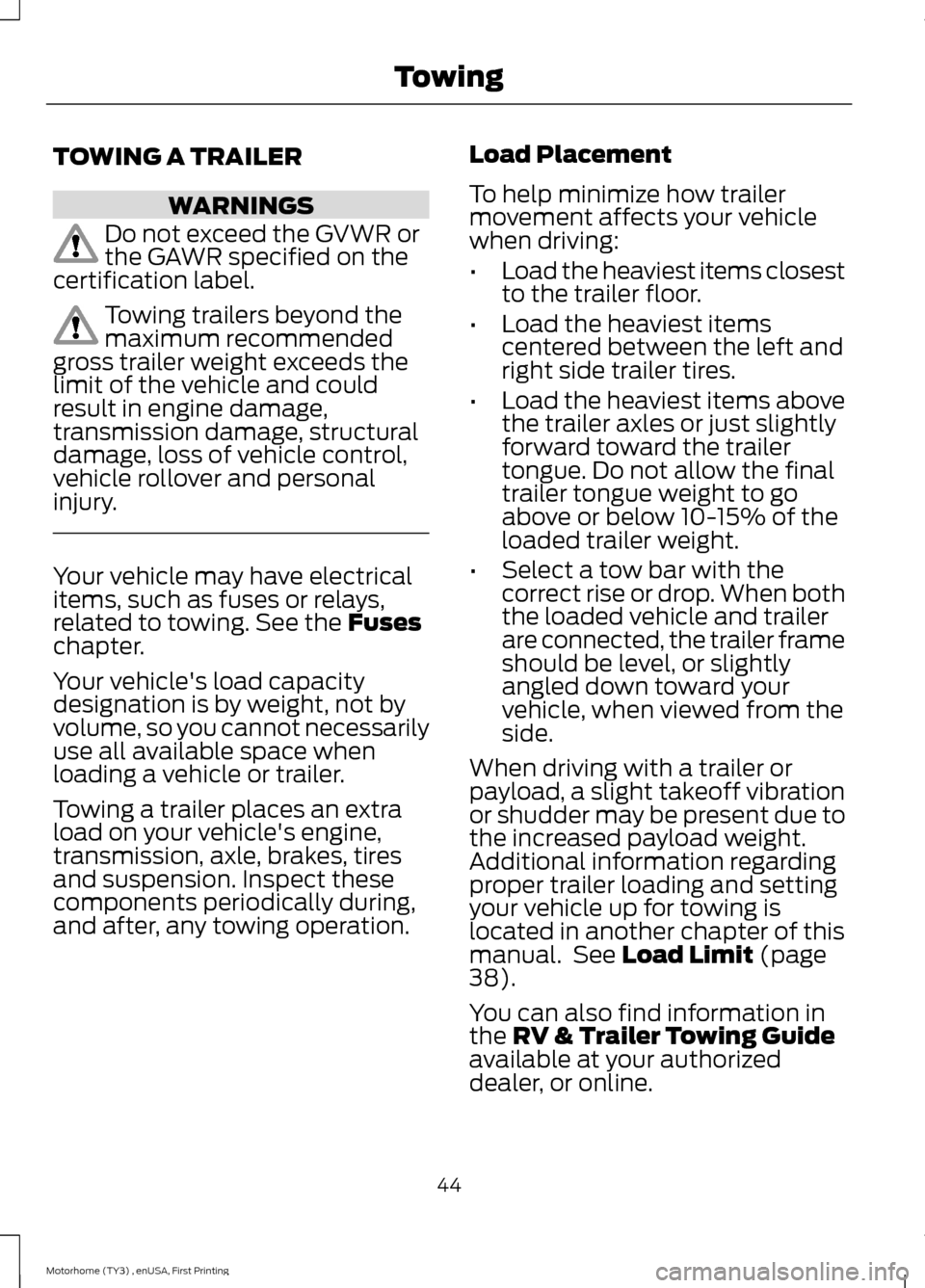2016 FORD F SERIES MOTORHOME AND COMMERCIAL CHASSIS manual transmission
[x] Cancel search: manual transmissionPage 4 of 154

Introduction
About This Manual...........................................3
Symbols Glossary.............................................3
California Proposition 65...............................5
Perchlorate..........................................................5
Ford Credit...........................................................5
Replacement PartsRecommendation........................................6
Special Notices.................................................6
Mobile CommunicationsEquipment.......................................................7
Export Unique Options...................................7
Environment
Protecting the Environment.........................8
Steering Wheel
Adjusting the Steering Wheel......................9
Cruise Control....................................................9
Wipers and Washers
Windshield Wipers.........................................10
Windshield Washers......................................10
Lighting
Lighting Control................................................11
Instrument Lighting Dimmer........................11
Daytime Running Lamps..............................12
Direction Indicators.........................................12
Instrument Cluster
Gauges.................................................................13
Warning Lamps and Indicators..................15
Audible Warnings and Indicators...............17
Information Displays
General Information.......................................18
Information Messages..................................19
Starting and Stopping theEngine
General Information......................................22
Ignition Switch.................................................22
Starting a Gasoline Engine.........................22
Engine Block Heater......................................24
Fuel and Refueling
Safety Precautions........................................25
Fuel Quality......................................................26
Running Out of Fuel......................................26
Refueling............................................................27
Fuel Consumption.........................................28
Emission Control System............................29
Transmission
Automatic Transmission.............................32
Brakes
General Information......................................35
Hints on Driving With Anti-LockBrakes.............................................................35
Parking Brake...................................................36
Cruise Control
Principle of Operation...................................37
Using Cruise Control......................................37
Load Carrying
Load Limit.........................................................38
Towing
Towing a Trailer...............................................44
Recommended Towing Weights..............45
Essential Towing Checks.............................47
Transporting the Vehicle.............................49
Towing the Vehicle on Four Wheels.......50
1Motorhome (TY3) , enUSA, First PrintingTable of Contents
Page 47 of 154

TOWING A TRAILER
WARNINGS
Do not exceed the GVWR orthe GAWR specified on thecertification label.
Towing trailers beyond themaximum recommendedgross trailer weight exceeds thelimit of the vehicle and couldresult in engine damage,transmission damage, structuraldamage, loss of vehicle control,vehicle rollover and personalinjury.
Your vehicle may have electricalitems, such as fuses or relays,related to towing. See the Fuseschapter.
Your vehicle's load capacitydesignation is by weight, not byvolume, so you cannot necessarilyuse all available space whenloading a vehicle or trailer.
Towing a trailer places an extraload on your vehicle's engine,transmission, axle, brakes, tiresand suspension. Inspect thesecomponents periodically during,and after, any towing operation.
Load Placement
To help minimize how trailermovement affects your vehiclewhen driving:
•Load the heaviest items closestto the trailer floor.
•Load the heaviest itemscentered between the left andright side trailer tires.
•Load the heaviest items abovethe trailer axles or just slightlyforward toward the trailertongue. Do not allow the finaltrailer tongue weight to goabove or below 10-15% of theloaded trailer weight.
•Select a tow bar with thecorrect rise or drop. When boththe loaded vehicle and trailerare connected, the trailer frameshould be level, or slightlyangled down toward yourvehicle, when viewed from theside.
When driving with a trailer orpayload, a slight takeoff vibrationor shudder may be present due tothe increased payload weight.Additional information regardingproper trailer loading and settingyour vehicle up for towing islocated in another chapter of thismanual. See Load Limit (page38).
You can also find information inthe RV & Trailer Towing Guideavailable at your authorizeddealer, or online.
44Motorhome (TY3) , enUSA, First PrintingTowing
Page 51 of 154

Trailer Brakes
WARNING
Do not connect a trailer's hydraulicbrake system directly to yourvehicle's brake system. Your vehiclemay not have enough braking power andyour chances of having a collision greatlyincrease.
Electric brakes and manual, automatic orsurge-type trailer brakes are safe if youinstall them properly and adjust them tothe manufacturer's specifications. Thetrailer brakes must meet local and federalregulations.
The rating for the tow vehicle's brakingsystem operation is at the gross vehicleweight rating, not the gross combinedweight rating.
Separate functioning brake systemsare required for safe control of towedvehicles and trailers weighing morethan 1500 pounds (680 kilograms)when loaded.
Trailer Lamps
WARNING
Never connect any trailer lamp wiringto the vehicle's tail lamp wiring; thismay damage the electrical systemresulting in fire. Contact your authorizeddealer as soon as possible for assistancein proper trailer tow wiring installation.Additional electrical equipment may berequired.
Trailer lamps are required on most towedvehicles. Make sure all running lights, brakelights, direction indicators and hazard lightsare working.
Before Towing a Trailer
Practice turning, stopping and backing upto get the feel of your vehicle-trailercombination before starting on a trip.When turning, make wider turns so thetrailer wheels clear curbs and otherobstacles.
When Towing a Trailer
•Do not drive faster than 70 mph(113 km/h) during the first 500 mi(800 km).
•Do not make full-throttle starts.
•Check your hitch, electrical connectionsand trailer wheel lug nuts thoroughlyafter you have traveled 50 mi (80 km).
•When stopped in congested or heavytraffic during hot weather, place thegearshift in park (P) to aid engine andtransmission cooling and to help airconditioning performance.
•Switch off the speed control withheavy loads or in hilly terrain. Thespeed control may turn offautomatically when you are towing onlong, steep grades.
•Shift to a lower gear when driving downa long or steep hill. Do not apply thebrakes continuously, as they mayoverheat and become less effective.
•If your transmission is equipped with aGrade Assist or Tow/Haul feature, usethis feature when towing. This providesengine braking and helps eliminateexcessive transmission shifting foroptimum fuel economy andtransmission cooling.
•Allow more distance for stopping witha trailer attached. Anticipate stops andbrake gradually.
•Avoid parking on a grade. However, ifyou must park on a grade:
1.Turn the steering wheel to point yourvehicle tires away from traffic flow.
48Motorhome (TY3) , enUSA, First PrintingTowing
Page 150 of 154

A
About This Manual...........................................3ABSSee: Brakes.............................................................35ABS driving hintsSee: Hints on Driving With Anti-LockBrakes..................................................................35AccessoriesSee: Replacement PartsRecommendation..............................................6Adjusting the Steering Wheel......................9Audible Warnings and Indicators...............17Fail-Safe Cooling Warning Chime...................17Headlamps On Warning Chime.......................17Key in Ignition Warning Chime..........................17Parking Brake On Warning Chime...................17Shift to Park Warning Chime.............................17Automatic Transmission.............................32Brake-Shift Interlock...........................................34If Your Vehicle Gets Stuck In Mud orSnow....................................................................34Understanding the Positions of YourAutomatic Transmission...............................32Automatic Transmission FluidCheck...............................................................87Adjusting automatic transmission fluidlevels....................................................................88Automatic transmission fluid filter...............88Correct fluid level..................................................87High fluid level.......................................................88Low fluid level........................................................87
B
Brake Fluid Check..........................................88Hydroboost............................................................89Hydromax...............................................................89Brakes.................................................................35General Information............................................35Breaking-In........................................................51
C
California Proposition 65...............................5Capacities and Specifications.................122Specifications.......................................................123
Car WashSee: Cleaning the Exterior................................94Changing a Fuse............................................80Fuses........................................................................80Changing a Road Wheel.............................114Dissimilar Spare Wheel and Tire AssemblyInformation.......................................................114Tire Change Procedure......................................115Changing the 12V Battery.............................91Battery relearn.......................................................92Changing the Engine Air Filter...................93Cleaning the Alloy Wheels.........................95Cleaning the Engine......................................94Cleaning the Exterior....................................94Exterior Chrome Parts........................................94Exterior Plastic Parts..........................................94Stripes or Graphics..............................................94Underbody..............................................................94Coolant CheckSee: Engine Coolant Check..............................84Cruise Control....................................................9Principle of Operation.........................................37Cruise controlSee: Using Cruise Control..................................37Customer Assistance....................................57
D
Daytime Running Lamps..............................12Direction Indicators.........................................12Driving Hints......................................................51Driving Through Water..................................52DRLSee: Daytime Running Lamps..........................12
E
Economical Driving.........................................51Emission Control System............................29On-Board Diagnostics (OBD-II).....................30Readiness for Inspection/Maintenance(I/M) Testing.....................................................30Engine Block Heater......................................24Using the Engine Block Heater........................24
147Motorhome (TY3) , enUSA, First PrintingIndex